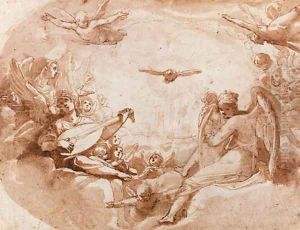Raffaello Motta (Raffaellino Da Reggio) Paintings
Raffaello Motta, more commonly known by his nickname Raffaellino da Reggio, was an Italian painter of the Mannerist style who made significant contributions to the Italian Renaissance art movement. Born in 1550 in Codemondo, near Reggio Emilia, he was a prominent figure in the late Renaissance period, known for his sophisticated technique and the emotional depth of his work. Despite his relatively short life, Raffaellino da Reggio left behind a legacy that continues to be celebrated for its artistic brilliance and innovation.
In the early phases of his career, Raffaellino was heavily influenced by the works of Correggio and Parmigianino, which is evident in his mastery of chiaroscuro and the graceful elongation of his figures. However, it was his association with the renowned artist Federico Zuccari that had a profound impact on his style and career trajectory. Raffaellino worked with Zuccari on the decoration of the Sala Regia in the Vatican, a project that marked one of his most significant achievements. His work in Rome, particularly in the Vatican, allowed him to immerse himself in the heart of the Renaissance art world, where he absorbed the influence of the great masters, including Raphael and Michelangelo.
Raffaellino's work is characterized by its dynamic compositions, vibrant color palette, and the emotional intensity of its figures. His religious paintings, in particular, reflect a deep spiritual fervor, combined with a meticulous attention to detail and a profound sense of humanism. One of his most famous works, ‘The Assumption of the Virgin’, demonstrates his ability to convey celestial beauty and divine light, capturing the essence of the spiritual realm with remarkable intensity.
Tragically, Raffaellino da Reggio's life was cut short when he died in 1578, at the age of 28. His premature death was a significant loss to the art world; however, his contributions to the Italian Renaissance have endured. Today, Raffaellino is remembered not only for his artistic talent but also for his role in the evolution of Mannerism, bridging the gap between the High Renaissance and the Baroque period that followed. His works can be found in various Italian churches and collections, serving as a testament to his enduring influence on the world of art.
